|
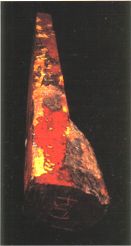 A good shamisen is generally determined by the excellent quality of the wood used, and its price depends on the pattern, color and density of the redsander wood Excellent redsander wood has dunelike wave patterns. Redsander wood is red in the beginning but gradually turns blackish after being exposed to air as the iron content oxidizes. A good shamisen is generally determined by the excellent quality of the wood used, and its price depends on the pattern, color and density of the redsander wood Excellent redsander wood has dunelike wave patterns. Redsander wood is red in the beginning but gradually turns blackish after being exposed to air as the iron content oxidizes.
|
|
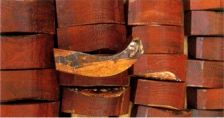 The top
part(head) of the neck is called"tenjin".This is tenjin before
being processed. The top
part(head) of the neck is called"tenjin".This is tenjin before
being processed.
|
|
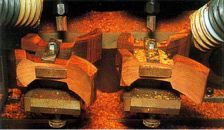 Keiji Hoshino of
Kumagayakikuoka: "In making the neck we have to decide the center of the material before we run it through the machine; it's a job for a skilled master " Keiji Hoshino of
Kumagayakikuoka: "In making the neck we have to decide the center of the material before we run it through the machine; it's a job for a skilled master "
|
|
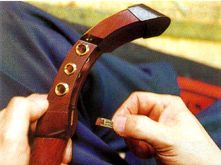 A protrusion is embedded to make
"sawari" below the tuning pegs. The indentations of sawari are so subtle that they are not noticeable even when observed up close. A protrusion is embedded to make
"sawari" below the tuning pegs. The indentations of sawari are so subtle that they are not noticeable even when observed up close.
|
|
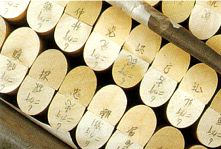 "Karitsugi" (temporary joints) are attached so that the joints are not damaged when dismantling the neck for transporting the
shamisen. The letters written in Chinese character are for matching karitsugi (2 per each set). "Karitsugi" (temporary joints) are attached so that the joints are not damaged when dismantling the neck for transporting the
shamisen. The letters written in Chinese character are for matching karitsugi (2 per each set).
|
|
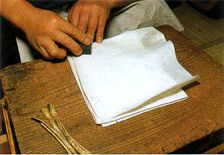 Dried hide that looks like drawing paper is moistened before stretching. They then scrape off the cuticle where adhesive is to be applied. Dried hide that looks like drawing paper is moistened before stretching. They then scrape off the cuticle where adhesive is to be applied.
|
|
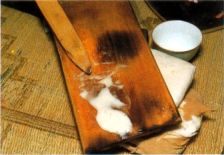 Kneaded sticky rice powder is used to glue the hide to the body. Kneaded sticky rice powder is used to glue the hide to the body.
|
|
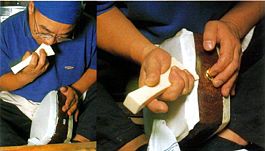 Kinji Katoh founded his own shop Shamisen Katoh in Arakawa Ward, Tokyo in 1989 A part of the shop is his workspace and also acts as a hall for original concerts. Visit http://www shamisen-Katoh.com for more details on Shamisen
Katoh. Kinji Katoh founded his own shop Shamisen Katoh in Arakawa Ward, Tokyo in 1989 A part of the shop is his workspace and also acts as a hall for original concerts. Visit http://www shamisen-Katoh.com for more details on Shamisen
Katoh.
|

Shinichi Kinoshita is the winner of the Tsugaru Jamisen National Meet 2000 Tisato Yamada Cup Competition at which only professional players gathered While he says most people replace their hide every one
to three months, or six months at the most, he leaves his hide on for two to three years. "After stretching another hide on the
shamisen, it becomes a totally different shamisen It's not just the player's sound, it's also the stretcher's sound."

|
The
hide is stretched over the body using a rope and 20 kisen(wooden
clamps).The process requires so much power that Kato begins to pant.
When katoh stretched a hide for a famous player,the late
Chikuzan Takahashi,the task was so difficult that he ruptured 18
front-side sheets and 15 backside sheets."After spoiling so many
sheets of hide I didn't have any good ones left,"says
Katoh."but I felt I had conquered one large hill in the stretching
of tsugaru jamisen hide by doing that job for Chikuzan."
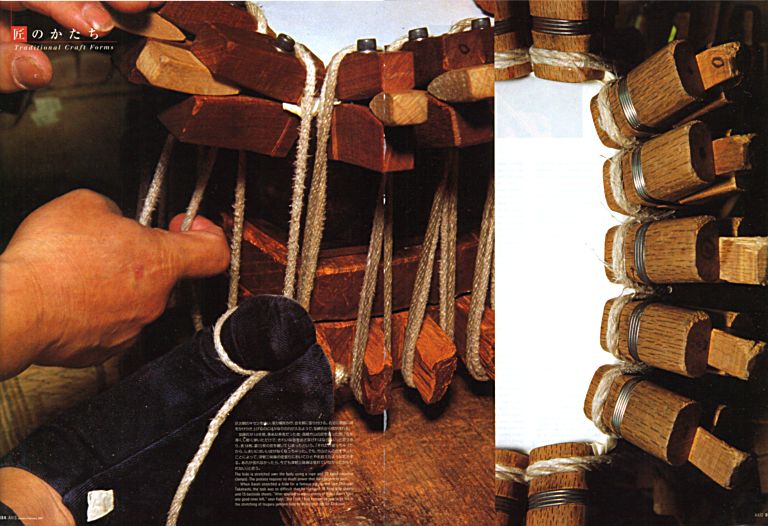
|

 A good shamisen is generally determined by the excellent quality of the wood used, and its price depends on the pattern, color and density of the redsander wood Excellent redsander wood has dunelike wave patterns. Redsander wood is red in the beginning but gradually turns blackish after being exposed to air as the iron content oxidizes.
A good shamisen is generally determined by the excellent quality of the wood used, and its price depends on the pattern, color and density of the redsander wood Excellent redsander wood has dunelike wave patterns. Redsander wood is red in the beginning but gradually turns blackish after being exposed to air as the iron content oxidizes. The top
part(head) of the neck is called"tenjin".This is tenjin before
being processed.
The top
part(head) of the neck is called"tenjin".This is tenjin before
being processed. Keiji Hoshino of
Kumagayakikuoka: "In making the neck we have to decide the center of the material before we run it through the machine; it's a job for a skilled master "
Keiji Hoshino of
Kumagayakikuoka: "In making the neck we have to decide the center of the material before we run it through the machine; it's a job for a skilled master "  A protrusion is embedded to make
"sawari" below the tuning pegs. The indentations of sawari are so subtle that they are not noticeable even when observed up close.
A protrusion is embedded to make
"sawari" below the tuning pegs. The indentations of sawari are so subtle that they are not noticeable even when observed up close. "Karitsugi" (temporary joints) are attached so that the joints are not damaged when dismantling the neck for transporting the
shamisen. The letters written in Chinese character are for matching karitsugi (2 per each set).
"Karitsugi" (temporary joints) are attached so that the joints are not damaged when dismantling the neck for transporting the
shamisen. The letters written in Chinese character are for matching karitsugi (2 per each set). Dried hide that looks like drawing paper is moistened before stretching. They then scrape off the cuticle where adhesive is to be applied.
Dried hide that looks like drawing paper is moistened before stretching. They then scrape off the cuticle where adhesive is to be applied.  Kneaded sticky rice powder is used to glue the hide to the body.
Kneaded sticky rice powder is used to glue the hide to the body. Kinji Katoh founded his own shop Shamisen Katoh in Arakawa Ward, Tokyo in 1989 A part of the shop is his workspace and also acts as a hall for original concerts. Visit http://www shamisen-Katoh.com for more details on Shamisen
Katoh.
Kinji Katoh founded his own shop Shamisen Katoh in Arakawa Ward, Tokyo in 1989 A part of the shop is his workspace and also acts as a hall for original concerts. Visit http://www shamisen-Katoh.com for more details on Shamisen
Katoh.
